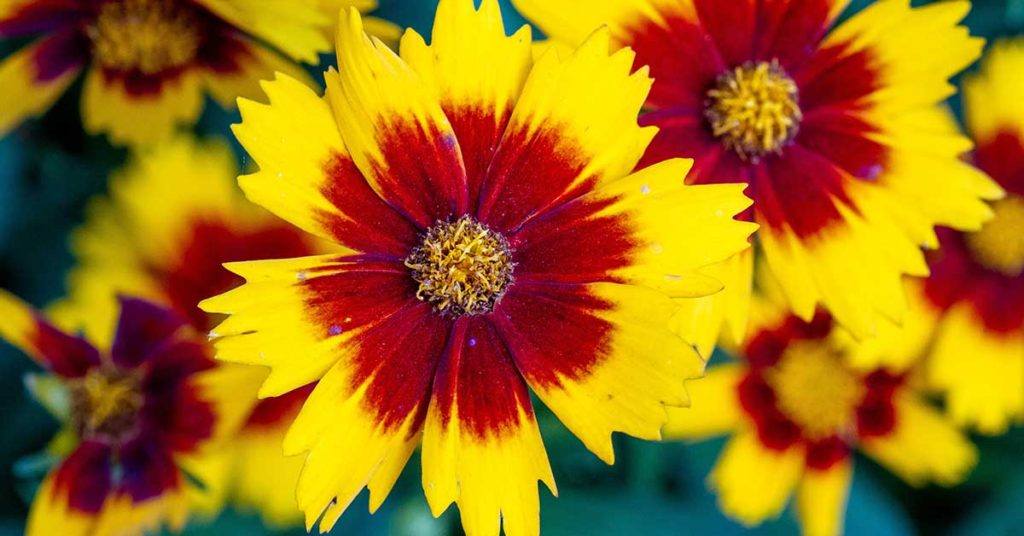Coreopsis is one of the most popular plants in any perennial garden and is valued for its prolonged blooming season and also the minimal hassle required to grow it. Also known as tickseed, this elegant native prairie plant produces cheerful, daisy-like blooms all through the summer, and flourishes despite the blazing sun and the sweltering heat. If you want to inspire more blooms, you should always deadhead coreopsis flowers that have died.
Coreopsis also has a valuable side to it as it attracts flocks of pollinators to gardens where it grows. Its visitors include butterflies, bees, and seed-eating birds. The native species of the coreopsis flowers bloom normally in gold and yellow shades, but they also come in a wider array that offers a kaleidoscope of colors that differ in size and growth habits and give up many varied options of color, shape, and size.
The coreopsis plant grows natively across the American continent, and besides the yellow variety, comes in red, white, and several combinations. The pleasingly toothed petal is its most distinct characteristic. To ensure that coreopsis flowers typically continue to re-bloom, deadhead the dead and wilting flowers regularly to ensure healthy growth throughout the year.
What is a coreopsis flower?

Coreopsis flowers are a genus of flowering plants and belong to the Asteraceae family, common among which are the tickseed and the calliopsis. The sunflower is also part of this same family. Coreopsis, which is also its botanical name, has over 80 species and is much treasured for its golden yellow bloom that flowers throughout summer. Its quaint name, tickseed, comes from the resemblance of the seeds to ticks.
Even though the native species of the flowers normally bloom in recognizable gold and yellow shades, there is also a vast array of colors to choose from. Depending on where it is grown and also the variety, coreopsis can be an annual or a perennial plant. The tickseeds favor warm weather, but most of the varieties thrive in a broad range of hardiness zones (4 to 10 – USDA).
The upright plant grows up to a length of 4 feet, though many varieties bloom at a length of 12 inches and can range anywhere between 12 and 36 inches.
When do coreopsis bloom
The coreopsis flowers sprout at various times, but you can expect a full bloom from early spring till late fall. Normally the coreopsis plants require little care when they are grown in their favored environment and thrive throughout the year. For that, the soil should be well-drained and receive plenty of sunlight. And enough space all around to enable sufficient air circulation and help them spread all around to bloom.
The coreopsis plant is drought-tolerant, requires minimum maintenance, and produces a long-lasting bloom. This makes it a perfect flower bed or a line for a border. With 80 varieties and more, there are plenty of choices to suit every need. The flowers typically bloom starting in early summer. They then continue to flower sporadically till the first frost. They also attract a variety of pollinators, including hummingbirds, butterflies, and bees.
Why deadhead coreopsis flowers
As with any other flowering plant, the flowers die. So, you need to get rid of the spent flowers to help the buds and healthy flowers flourish. The taller among the plants have to be stalked as they become mature to prevent the stems from falling over.
If you allow a lot of dead and dying flowers to hang out on your coreopsis plants, much of the energy of the plant is lost in the stems of those dead parts. The growing buds and the fresh flowers lose out.
One of the most efficient ways to ensure a full bloom throughout summer and even into fall is to remove any spent bloom. This is also known as deadheading the plants. If the coreopsis is perennial in your area, you will need to divide or even replace the plants every 3 to 5 years.
How to deadhead coreopsis flowers
To encourage a full bloom, snip off spent flower heads . Or, you can just shear back the entire plant following the first flowering. Deadheading is nothing more than the removal of the wilting flowers. It is done by pruning the dead flowers from the coreopsis plants. But then again, pruning is not limited to deadheading the coreopsis flowers.You should also trim any overgrowth and excess leaves.
All you need to do is take your garden shears and snip them at the base of the flowers. It will take care of those ungainly dead flowers. It will also encourage new growth to emerge, creating a full bloom. Once you remove the dead flowers and the wilting stems, a lot of the plant’s energy gets redirected into the blooms. Another issue with coreopsis is that they do tend to get huge after a while. That is when you need to trim them back to prevent them from spilling onto a pathway. Do so if they intrude into the space of another plant as well.
You should not be worried too much about cutting it back too far as the blooming season ends. Just get deep and remove the parts that are getting tall and ungainly. If you want, you can also shape it a little. Just take your shears to the base of the dead and wilting flowers and leaves and remove them. Once the leaves have been on the ground for some time, some leaves might get a little woody underneath. If you notice any woody parts, just go ahead and remove them too.
Coreopsis attracts butterflies, bees, and birds during the summer. Several varieties of birds feed on the seed heads during the fall and summer. Deer normally stay away from the coreopsis plant.













